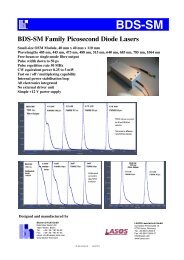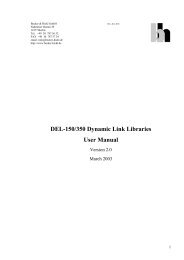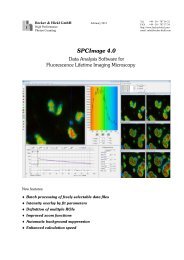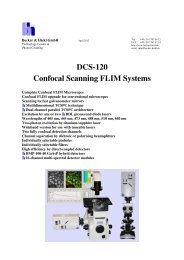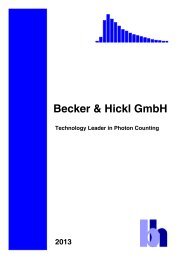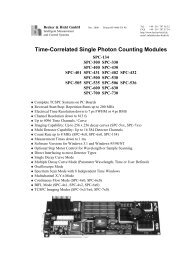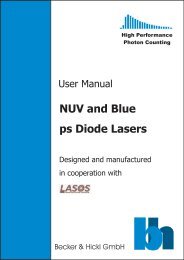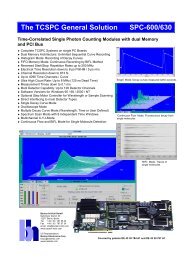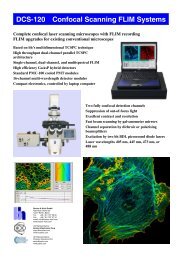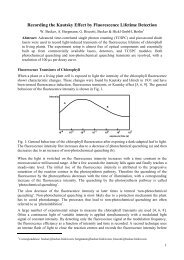OCF-401 Optical Constant Fraction Discriminator - Becker & Hickl ...
OCF-401 Optical Constant Fraction Discriminator - Becker & Hickl ...
OCF-401 Optical Constant Fraction Discriminator - Becker & Hickl ...
Create successful ePaper yourself
Turn your PDF publications into a flip-book with our unique Google optimized e-Paper software.
<strong>Becker</strong> & <strong>Hickl</strong> GmbH March. 2002 Printer HP 4500 PS<br />
Intelligent Measurement<br />
and Control Systems<br />
<strong>OCF</strong>-<strong>401</strong><br />
<strong>Optical</strong> <strong>Constant</strong> <strong>Fraction</strong> <strong>Discriminator</strong><br />
Accurate triggering to optical pulses<br />
Negligible influence of amplitude fluctuations<br />
Time walk < 30 ps for 1ns pulse with 1:10 amplitude fluctuation<br />
1V / 4ns output pulse<br />
Single +5V supply<br />
Trigger indicator LED<br />
Tel. +49 / 30 / 787 56 32<br />
FAX +49 / 30 / 787 57 34<br />
http://www.becker-hickl.com<br />
email: info@becker-hickl.com<br />
1
Introduction<br />
The <strong>OCF</strong>-<strong>401</strong> is used to derive electrical trigger pulses from optical pulses. Due to the<br />
constant fraction trigger principle the trigger point is widely independent of the pulse<br />
amplitude. Typical applications are triggering of sampling/boxcar measurements, triggering of<br />
streak cameras and synchronisation of photon counting experiments.<br />
The principle is shown in the figure<br />
right.<br />
The optical pulse is detected by a fast<br />
PIN photodiode. The electrical pulse<br />
goes to a leading edge discriminator<br />
and to a zero cross dicriminator.<br />
The zero cross discriminator is a<br />
differential comparator that gets the<br />
photodiode pulse at both inputs. The<br />
pulse at the ‘-’ input is delayed by a<br />
fraction of the pulse width. Therefore,<br />
the comparator effectively sees a<br />
bipolar pulse. Ideally, the zero cross<br />
point of this pulse does not depend on<br />
the pulse amplitude. Therefore the<br />
negative transition of the zero cross discriminator is is a excellent indicator of the temporal<br />
position of the optical pulse.<br />
Of course, the switching point of the zero cross discriminator must be close to zero. This<br />
causes this discriminator to trigger not only to the light pulses but also to noise and spurious<br />
signals. To obtain a defined trigger threshold, a leading edge discriminator is used in parallel<br />
with the zero cross discriminator. The leading edge discriminator responds when the pulse<br />
exceeds an adjustable threshold. The output pulse of the leading edge discriminator is used to<br />
enable the output pulse stage of the <strong>OCF</strong>-<strong>401</strong> a few ns around the transition from the zero<br />
cross discriminator.<br />
As a result, the <strong>OCF</strong>-<strong>401</strong> delivers an output pulse only for input pulses above a selectable<br />
energy, but the trigger delay is almost idependent of the pulse energy.<br />
Installation<br />
The <strong>OCF</strong>-<strong>401</strong> device is shown in figure 2.<br />
The <strong>OCF</strong>-<strong>401</strong> requires a single +5V DC power supply. Before switching on, please make sure<br />
that the power connections are not reversed and a voltage of +5.5V is not exceeded. The<br />
device will work in a voltage range of 4.5V to 5.5V. The specifications apply to a supply<br />
voltage of 5.0V.<br />
After switching on the power, feed the laser beem to the photodiode of the device. The active<br />
area is 0.5mm x 0.5mm wide. Do not focus the light to a smaller area - the linearity degrades<br />
at small focus diameters. The best intensity range for pulses of about 1ns width is around a<br />
few 10mW at 500nm.<br />
2<br />
PIN Photodiode<br />
Threshold<br />
Delay<br />
+<br />
-<br />
+<br />
-<br />
Leading<br />
Edge<br />
<strong>Discriminator</strong><br />
Zero Cross<br />
<strong>Discriminator</strong><br />
enable<br />
zero<br />
cross<br />
Pulse<br />
Fig. 1: Block diagram of <strong>OCF</strong>-<strong>401</strong><br />
Out
Photodiode<br />
Output, 50 Ohm SMA<br />
Fig.2: <strong>OCF</strong>-<strong>401</strong><br />
Power Supply +5V<br />
Trigger-Indikator-LED<br />
-<br />
+<br />
-<br />
+<br />
Zero Cross Level Adjust<br />
Threshold Adjust<br />
When the light pulses hit the photodiode the trigger indicator LED should flash or turn on<br />
steadily at higher repetition rates. Find the intensity at which the device just starts to trigger.<br />
For normal operation use about 5 to 10 times this intensity.<br />
The output pulse is +1 V / 4 ns at 50 Ω. Other pulse durations are available on request -<br />
contact <strong>Becker</strong> & <strong>Hickl</strong>.<br />
The device is optimised for an optical pulse duration of less than 2ns. If you have longer<br />
pulses the trigger accuracy can be improved by replacing the delay line for the pulse shaping.<br />
Contact <strong>Becker</strong> & <strong>Hickl</strong>.<br />
Adjusting Threshold and Zero Cross Level<br />
The <strong>OCF</strong>-<strong>401</strong> module has two adjust screws for the leding edge discriminator threshold and<br />
the zero cross level. When delivered by <strong>Becker</strong> & <strong>Hickl</strong>, the <strong>OCF</strong>-<strong>401</strong> modules are adjusted to<br />
yield good results with most common input pulse shapes. Should there be a re-adjustment<br />
required, please observe the following recommendations.<br />
As described in figure 1, the leading edge discriminator enables the zero cross trigger<br />
circuitry. When it is enabled, the zero cross trigger will respond to very small signals.<br />
Therefore the threshold of the leading edge trigger is adjusted to trigger on the signal pulses<br />
from the photodiode but not on small noise peaks or spurious light signals (fig. 3). If the<br />
threshold is set too low, the zero cross trigger will be enabled by spurios input signals or it<br />
will be always enabled. In this situation false trigger events due to noise and spurious signals<br />
can occur. If the threshold is set too high, the sensitivity will be impaired.<br />
3
4<br />
Threshold too high<br />
no triggering<br />
Threshold correct<br />
triggered by<br />
input pulse<br />
Threshold too low<br />
triggered by noise<br />
Threshold too low<br />
always triggered<br />
Fig. 3: Effect of threshold adjust<br />
The figure below illustrates the influence of the zero cross level.<br />
ZCL>>0<br />
ZCL=0<br />
ZCL
If the <strong>OCF</strong>-<strong>401</strong> is completely de-adjusted we recommend the following procedure:<br />
Set the "Threshold" about three turns from the left end. Apply a signal which just triggers the<br />
device. Adjust "Zero Cross Level" and decrease the light intensity until you have found the<br />
range where the device has the highest sensitivity. Set the "Zero Cross Level" to the middle of<br />
this range. The zero cross level will be close to zero now. Now increase the light intensity to<br />
about twice the value found before and increase "Threshold" until the device stops triggering.<br />
After this the device should be in a useful state. To optimize the timing characteristic proceed<br />
as follows:<br />
Find the light intensity at which the device just starts to trigger. Apply a light intensity about 5<br />
to 10 times higher than this value. Optimise the "Zero Cross Level" for a minimum delay<br />
variation in this range.<br />
Specification<br />
Output pulse amplitude + 1V, +2V on request<br />
Output pulse duration 4 ns (higher values on request)<br />
Output rise and fall times 1 ns<br />
Trigger rate max. 125 MHz<br />
Delay variation with input amplitude<br />
electrical +/- 30 ps in 1:100 amplitude range<br />
with photodiode +/- 30 ps in 1:10 amplitude range<br />
Input pulse power 2 mW to 50mW (1ns, 600nm)<br />
max. input power 400 mW average<br />
Wavelength range 320 nm to 1000 nm<br />
Power supply 4.5 V to 5.5 V<br />
Power supply current 270 mA<br />
All values refer to the nominal supply voltage of +5V and an ambient temperature of 25° C.<br />
Technical Support<br />
We are pleased to support you in all problems concerning the measurement of fast electrical<br />
or optical signals. This includes the installation of the <strong>OCF</strong>-<strong>401</strong> and its connection to other bh<br />
devices, application and measurement problems, the technical environment and physical<br />
problems related to short time measurement techniques. Simply call us or send us an email.<br />
<strong>Becker</strong> & <strong>Hickl</strong> GmbH<br />
Nahmitzer Damm 30<br />
12277 Berlin<br />
Tel. +49 / 30 / 787 56 32<br />
FAX +49 / 30 / 787 57 34<br />
email: info@becker-hickl.com<br />
http://www.becker-hickl.com<br />
5



